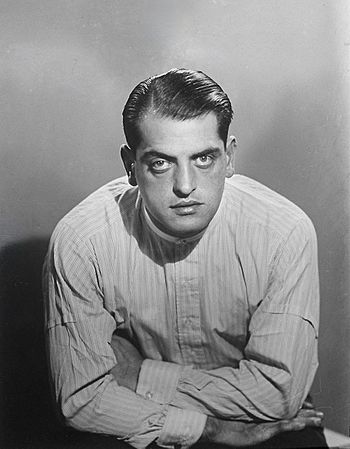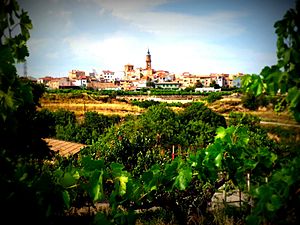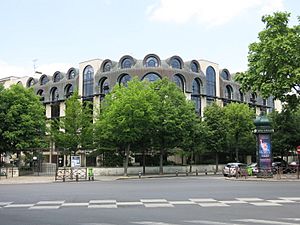Luis Buñuel facts for kids
Quick facts for kids
Luis Buñuel
|
|
|---|---|

Buñuel in 1929
|
|
| Born |
Luis Buñuel Portolés
22 February 1900 Calanda, Aragon, Spain
|
| Died | 29 July 1983 (aged 83) Mexico City, Mexico
|
| Citizenship | |
| Alma mater | University of Madrid |
| Occupation | Filmmaker |
| Years active | 1929–1977 |
|
Notable work
|
Un Chien Andalou, L’Age d’Or, Los Olvidados, Viridiana, El ángel exterminador, Diary of a Chambermaid, Simón del desierto, Belle de Jour, Le Charme discret de la bourgeoisie, Cet obscur objet du désir |
| Spouse(s) |
Jeanne Rucar
(m. 1934) |
| Children | Juan Luis Buñuel (1934–2017) Rafael Buñuel |
| Relatives | Diego Buñuel (grandson) |
Luis Buñuel Portolés (Spanish: [ˈlwiz βuˈɲwel poɾtoˈles]; 22 February 1900 – 29 July 1983) was a Spanish filmmaker who worked in France, Mexico, and Spain. He has been widely considered by many film critics, historians, and directors to be one of the greatest and most influential filmmakers of all time.
Often associated with the surrealist movement of the 1920s, Buñuel created films from the 1920s through the 1970s. Having worked in Europe and North America, and in French and Spanish, Buñuel also directed films spanning various genres. Despite this variety, filmmaker John Huston believed that, regardless of genre, a Buñuel film is so distinctive as to be instantly recognizable, or, as Ingmar Bergman put it, "Buñuel nearly always made Buñuel films".
Seven of Buñuel's films are included in Sight & Sound's 2012 critics' poll of the top 250 films of all time. Fifteen of his films are included in the They Shoot Pictures, Don't They? list of the 1,000 greatest films of all time, second only to Jean-Luc Godard, with sixteen, and he ranks number 13 on their list of the top 250 directors. David Thomson names him as one of the greatest directors.
When Buñuel died at the age of 83, his obituary in The New York Times called him "an iconoclast, moralist, and revolutionary who was a leader of avant-garde surrealism in his youth and a dominant international movie director half a century later".
In 1982, Buñuel wrote (along with Carrière) his autobiography, Mon Dernier Soupir (My Last Sigh), which provides an account of his life, friends, and family as well as a representation of his eccentric personality. In it, he recounts dreams, encounters with many well-known writers, actors, and artists such as Pablo Picasso and Charlie Chaplin.
According to his wife, Jeanne, Buñuel died in Mexico City in 1983 from diabetes complications. Fuentes has recounted that Buñuel spent his last week in hospital discussing theology with the Jesuit brother Julián Pablo Fernández, a long time friend. His funeral was very private, involving only family and close friends, among them poets Octavio Paz and Homero Aridjis.
Early years

Buñuel was born on 22 February 1900 in Calanda, a small town in the Aragon region of Spain. His father was Leonardo Buñuel, also a native of Calanda, who had left home at the age of 14 to start a hardware business in Havana, Cuba, ultimately amassing a fortune and returning home to Calanda at the age of 43, in 1898. He married the 18-year-old daughter of the only innkeeper in Calanda, María Portolés Cerezuela. The oldest of seven children, Luis had two brothers, Alfonso and Leonardo, and four sisters: Alicia, Concepción, Margarita and María. He would later describe his birthplace by saying that in Calanda, "the Middle Ages lasted until World War I".
When Buñuel was four and a half months old, the family moved to Zaragoza, where they were one of the wealthiest families in town. In Zaragoza, Buñuel received a strict Jesuit education at the private Colegio del Salvador, starting at the age of seven and continuing for the next seven years. Even as a child, Buñuel was something of a cinematic showman; friends from that period described productions in which Buñuel would project shadows on a screen using a magic lantern and a bedsheet. He also excelled at boxing and playing the violin.
In 1917, he attended the University of Madrid, first studying agronomy then industrial engineering and finally switching to philosophy. He developed very close relationships with painter Salvador Dalí and poet Federico García Lorca, among other important Spanish creative artists living in the Residencia de Estudiantes, with the three friends forming the nucleus of the Spanish Surrealist avant-garde, and becoming known as members of "La Generación del 27". Buñuel was especially taken with García Lorca, later writing in his autobiography: "We liked each other instantly. Although we seemed to have little in common—I was a redneck from Aragon, and he an elegant Andalusian—we spent most of our time together... We used to sit on the grass in the evenings behind the Residencia (at that time, there were vast open spaces reaching to the horizon), and he would read me his poems. He read slowly and beautifully, and through him I began to discover a wholly new world." Buñuel's relationship with Dalí was somewhat more troubled, being tinged with jealousy over the growing intimacy between Dalí and Lorca and resentment over Dalí's early success as an artist.
Buñuel's interest in films was intensified by a viewing of Fritz Lang's Der müde Tod: "I came out of the Vieux Colombier [theater] completely transformed. Images could and did become for me the true means of expression. I decided to devote myself to the cinema".
Technique and influences
Buñuel's technique of filmmaking was strongly influenced by mise-en-scène, sound editing and use of music. Buñuel's style of directing was extremely economical; he shot films in a few weeks, rarely deviating from his script and shooting as much as possible in order to minimize editing time. He remained true throughout his working life to an operating philosophy that he articulated at the beginning of his career in 1928: "The guiding idea, the silent procession of images that are concrete, decisive, measured in space and time—in a word, the film—was first projected inside the brain of the filmmaker". In this, Buñuel has been compared with Alfred Hitchcock, another director famous for precision, efficiency and preplanning, for whom actually shooting the film was an anticlimax, since each man would know, in Buñuel's words, "exactly how each scene will be shot and what the final montage will be". According to actress Jeanne Moreau: "He was the only director I know who never threw away a shot. He had the film in his mind. When he said 'action' and 'cut,' you knew that what was in between the two would be printed."
Personal life
In 1926 he met his future wife, Jeanne Rucar Lefebvre, a gymnastics teacher who had won a bronze medal at the 1924 Paris Olympics. Buñuel courted her in a formal Aragonese manner, complete with a chaperone, and they married in 1934 despite a warning by Jean Epstein when Buñuel first proposed in 1930: "Jeanne, you are making a mistake... It's not right for you, don't marry him." The two remained married throughout his life and had two sons, Juan Luis and Rafael. Diego Buñuel, filmmaker and host of the National Geographic Channel's Don't Tell My Mother series, is their grandson.
Tributes
- In 1994, a retrospective of Buñuel's works was organized by the Kunst- und Ausstellungshalle in Bonn, as homage to one of the most internationally revered figures in world cinema. This was followed in the summer of 1996 by a commemoration of the centenary of the birth of cinema held by the Museo Nacional Centro de Arte Reina Sofía in Madrid, which included a unique retrospective, jointly sponsored by the King of Spain and the President of Mexico, called ¿Buñuel!. La mirada del siglo, honoring his special status as Spanish cinema's most emblematic figure.
- A secondary school in Zaragoza, Spain has been named for Buñuel: Instituto de Educación Secundaria Ies Luis Buñuel. Liceo Español Luis Buñuel, a Spanish international school, is in Neuilly-sur-Seine, France, near Paris.
- In Calanda, Spain a bust of the head of Luis Buñuel is on display at the Centro Buñuel Calanda (CBC), a museum devoted to the director. The mission of the CBC is to serve as a reference center both for connoisseurs of Buñuel and for anyone interested in the arts of Aragon.
- One of the main theatres at the Palais des Festivals et des Congrès, where the Cannes Film Festival is held, is named after him: Salle Buñuel.
- To mark the centenary of his birth, in 2000 the Cannes festival partnered with the Spanish film industry, to pay tribute to Luis Buñuel. This tribute consisted of three events: (1) the inauguration, for Cannes 2000, of the Palace's new Luis Buñuel room, (2) an original exhibition organized by Instituto de la Cinematografía y de las Artes Audiovisuales entitled "The Secret World of Buñuel", and (3) an exceptional projection of Viridiana, the Palme d'Or winner in 1961, in the presence of specially invited artists.
- The Luis Buñuel Film Institute (LBFI) is housed in the Downtown Independent Theatre, Los Angeles, and has as its mission: "to form the vital and innovative arena for the promotion of the work of Luis Buñuel, and a seminal resource for the development of new research, knowledge and scholarship on his life and work, extending across his body of films and writings".
- Liceo Español Luis Buñuel
Awards
Buñuel was given the Career Golden Lion in 1982 by the Venice Film Festival and the FIPRESCI Prize – Honorable Mention in 1969 by the Berlin International Film Festival. In 1977, he received the National Prize for Arts and Sciences for Fine Arts. At the 11th Moscow International Film Festival in 1979, he was awarded the Honorable Prize for his contribution to cinema. He was nominated once for the Nobel Prize in Literature in 1968.
See also
 In Spanish: Luis Buñuel para niños
In Spanish: Luis Buñuel para niños
- Art film
- Cinema of Mexico
- Cinema of Spain
- Experimental film
- Generation of '27
- List of atheists in film, radio, television and theater
- List of banned films
- Satire
- Surrealism
- Surrealist cinema



